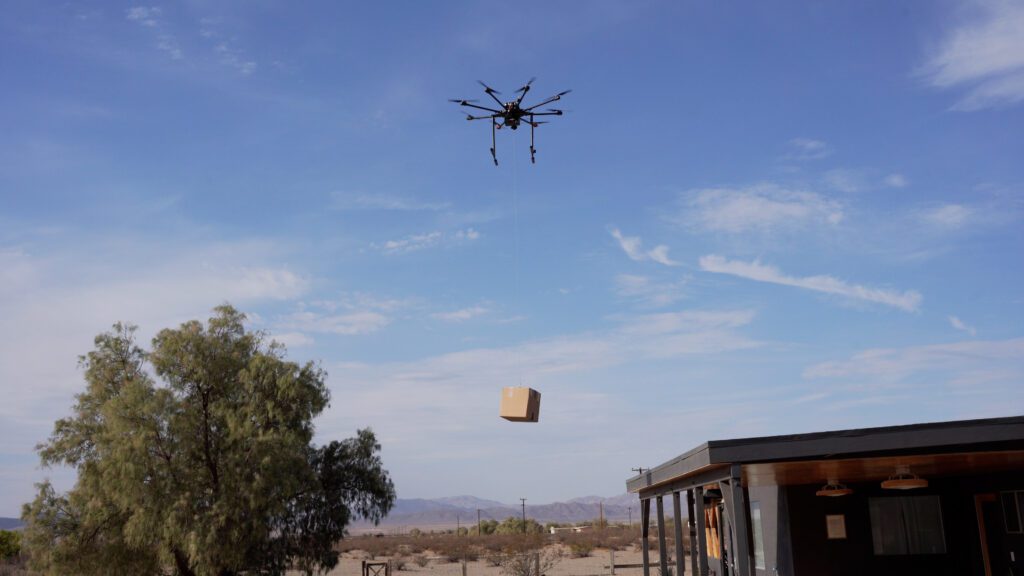
Los Angeles-based drone developer A2Z Drone Delivery just launched the second generation of its delivery winch system, along with a new integrated cargo drone. Pictured above is A2Z’s RDST delivering a package. (Photo: A2Z Drone Delivery)
Los Angeles-based commercial drone developer A2Z Drone Delivery recently announced the launch of a new integrated cargo drone and a second-generation delivery winch system. “We’ve been working on this delivery winch as our core product,” A2Z’s CEO Aaron Zhang told Avionics International. “Our mission is to center the product around consumer protection concerns—noise and privacy are issues that we identified early on from other companies such as Wing.”
A2Z’s solutions are designed for applications such as last-mile logistics, medical deliveries, search and rescue, and inter-site transport. One of A2Z’s early customers was DroneUp, the drone service provider for Walmart. The first generation of A2Z’s Rapid Delivery System, RDS1, was integrated into DroneUp’s residential delivery drone fleet following successful field tests. The RDS1 and RDS2 are compact tethered delivery systems that both incorporate redundant safety mechanisms including manual or automatic tether controls. The RDS1 was also selected by the company Nordic Unmanned for testing offshore logistics delivery in Norway.
Zhang explained that the RDS1 was designed for delivering packages from an altitude of up to 50 meters and for performing deliveries very quickly. Keeping the drones further away from people, and optimizing the delivery efficiency, enables safer overall operations.
“A major ask of our early customers was that they wanted to deliver using their own boxes, their own containers,” Zhang commented. “You can deliver any box and can auto-release the box so you don’t need a human receiver at the destination.”

A close-up of the RDS2 winch with a box attached for delivery (Photo: A2Z Drone Delivery)
The second-generation RDS2 has performed more than 2,000 test delivery flights and is deployed with six partners that are beta-testing the platform. The RDS2 includes new features such as a heavy-duty drive motor that enables deliveries of 22-pound payloads, which A2Z claims is the highest payload capacity on the market.
The second-generation system can also pick up payloads of up to 11 pounds while hovering. The RDS2 features an upgraded braided Kevlar tether that requires replacement less frequently than the RDS1. The system can include a general purpose manual-release hook for delivering or retrieving items like bags and buckets in addition to standard packages.
The new cargo drone launched by A2Z, the RDST, is a “ready-to-fly” commercial delivery drone that includes a factory-integrated RDS2 winch. The RDST features an upgraded ground control station, integrating RDS2 commands and telemetry along with open-source Q Ground Control mission planning software that can conduct pre-planned automated delivery missions without the need to land, according to the company.
A2Z’s delivery drone has a payload capacity of 11 pounds, collapsible rotors, and an octocopter configuration. The RDST also features open-source flight control software to facilitate easy integration with third-party hardware and software.

In an interview with Avionics, A2Z’s CTO Evan Hertafeld spoke about the challenge of building something that can reliably drop a box off at the end of a tether and that is also versatile. (Photo: A2Z Drone Delivery)
“The biggest advantage that we provide to our customers is that they can maintain visual line of sight during the entire delivery,” Zhang stated. “DroneUp, for example, takes off from a Walmart parking lot—they fly out one to two miles, and they have a tower that the operator is watching from. Because our delivery is from the air, you don’t need to land, you don’t need to ever go below the tree line. You’re able to basically do the whole thing under part 107.”
Currently, A2Z focuses solely on providing the product. “We’re not going through type certification or applying for any of these waivers just yet,” he noted.
A2Z’s Chief Technology Officer (CTO) Evan Hertafeld commented that most commercial drone applications are happening under Part 107, which comes with many restrictions. “A lot of our customers are using our product to operate within 107 and demonstrate to the FAA that it’s going fine,” he said.

According to CEO Aaron Zhang, one of the technical challenges of developing the RDS2 was the auto-release mechanism. (Photo: A2Z Drone Delivery)
Very few drone developers have the resources to pursue type certification with the FAA right now, Hertafeld commented. “These early operations are less about providing the service itself and more about demonstrating to the FAA that this is going well, we have followed all of the rules, and there have been no incidents,” he stated.
“Our stuff basically lets people walk up to the limits of what the FAA allows so that they can demonstrate that the technology and the industry is ready for a little more leash to be thrown out and for those regulations to be relaxed and enhanced to accommodate drones.”
Central to almost every drone operation, on the technology side, are trade-offs with the vehicle’s size, range, and batteries. Hertafeld remarked, “There’s no crazy revolutionary technology that has hit the scene. It’s just trying to find different combinations of propeller size and battery size for the application.”
“We’re coming close to the limits of what lithium-ion batteries can do,” he added.